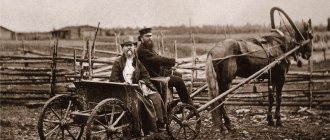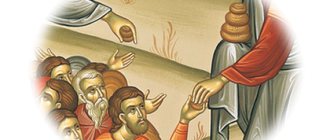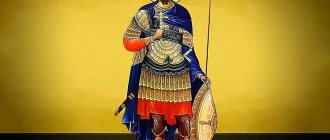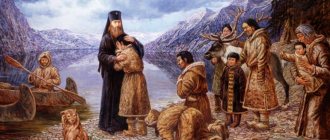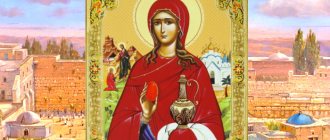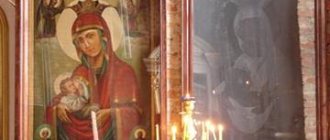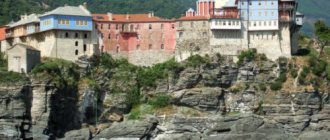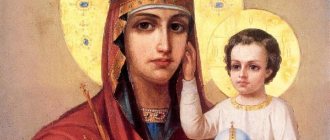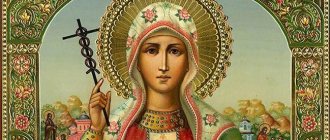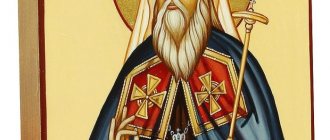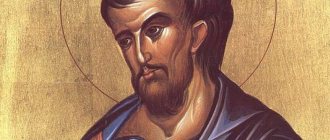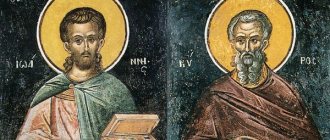"Save me, God!".
Thank you for visiting our website, before you start studying the information, please subscribe to our Orthodox community on Instagram, Lord, Save and Preserve † - https://www.instagram.com/spasi.gospodi/. The community has more than 60,000 subscribers. There are many of us like-minded people and we are growing quickly, we post prayers, sayings of saints, prayer requests, and timely post useful information about holidays and Orthodox events... Subscribe. Guardian Angel to you!
In difficult moments, every person remembers the church and the saints who help to survive the difficult moments of life. By coming to them with prayer, they help us find lost faith, be cured of serious illnesses, etc. One of the saints that many people go to is the icon of John of Kronstadt.
Basic biography facts
Below is a brief biography of the priest: from birth to death and canonization.
Years of life
Ivan Sergiev was born in the village. Sura of the Arkhangelsk province, in 1829. The boy’s birthday fell on October 19, in memory of Rev. John of Rylsky. That is why the baby was baptized with the name of the saint, and immediately after birth: they feared for the life of a very weak child.
Ivan’s life turned out to be long: John of Kronstadt died on December 20, 1908. Between two dates - 1829 and 1908. – lie 80 years of service to God and people.
Brief Life
Righteous John of Kronstadt went from a student at a theological school and a seminarian to a mitred archpriest, a shepherd known throughout the country.
Family
John's family belonged to the clergy. Grandfathers and great-grandfathers served as priests for 350 years. The boy's father, Ilya Mikhailovich, was a psalm-reader. From an early age, Vanya was also prepared for church service and was constantly taken to services. And from the age of 6, Ivan was sent to learn to read and write.
Studies
Father John later recalled that teaching was not easy for him. I was ashamed and embarrassed in front of my parents. But one day, after fervent prayer, Vanya felt that he could learn and understand the lessons. Since then he began to study better. Ivan was also the first to attend the seminary, where he entered after college.
In 1851, the son of a poor psalm-reader, the best graduate, was accepted at public expense into the St. Petersburg Theological Academy. Fellow students remembered Sergiev as a diligent student and a lover of reading. At the same time, Ivan constantly worked part-time, rewriting documents to help his mother and sisters.
In Kronstadt: the first years
After the Academy, John wanted to become a monk and missionary among the pagans. But then he decided to become a parish priest. After all, among the Orthodox there were many people who did not know God. So John Sergiev became a priest of St. Andrew's Cathedral in Kronstadt.
The unusual priest immediately attracted the attention of parishioners and the clergy. They did not understand and accept him immediately. After all, the young priest:
- strove to perform the liturgy every day, which was not accepted among priests;
- did not take money for services (baptism, wedding, funeral service, etc.) from the poor;
- he himself went around the poor quarters of the city, generously distributing alms from his own salary;
- He gave the last thing he had to the poor - right down to his own boots.
Famous Shepherd
And a few years later the priest became famous as a great man of prayer. Father John himself said that he was once asked to pray for two sick babies. Not daring to ask for healing, he asked only for the fulfillment of the will of the Lord. But one of the parishioners of St. Andrew’s Cathedral, who knew the priest, began to insistently demand that he ask God specifically for recovery. Father John made up his mind. And the children recovered.
Since then, people turned to the saint for prayer more and more often. The fame of the miracle worker turned out to be such that crowds of people constantly accompanied him around the city. After the service, the priest was not able to go home. He traveled to the homes of parishioners, where he was invited to perform a prayer service for the sick, confess, and receive communion.
Even during the service, telegrams and letters from all over the country with requests for prayer were constantly carried to the altar. The number of people wishing to confess to Father John was such that he, out of necessity, introduced general confession. These confessions made a stunning (although often ambiguous) impression on everyone who saw them. People repented out loud, named their sins loudly, and cried.
This is how the life of John of Kronstadt passed until his death. The shepherd said about himself that he was neither an ascetic nor an ascetic. He was constantly given expensive gifts; huge sums of money passed through the hands of the priest (up to 1 million rubles a year), which he immediately distributed to those in need.
Father John's feat consisted of serving people, giving of himself without reserve.
About marriage
Father John's wife, Elizaveta Konstantinovna, was the daughter of the priest of St. Andrew's Cathedral in Kronstadt, Konstantin Nesvitsky. Elizabeth was considered, as they said then, “a bride with a place.” This meant that the priest Constantine, retiring due to old age, left his place at the cathedral to his future son-in-law. The marriage contract of Father John Sergiev stated his obligation to support not only his wife, but also her parents.
But Father John turned out to be unmercenary and a poor provider. In addition, he decided to live with his wife without marital relations, like brother and sister. The family's reaction was violent. For 20 years, the priest constantly had conflicts with relatives and his wife. Elizabeth turned to the bishop, asking not to give her husband a salary in hand. She also demanded that Father John be forced to fulfill the duty of marital relations.
The young priest was also viewed with bewilderment by his superiors, who looked suspiciously at his zeal “for God.” But Father John patiently endured reproaches and reproaches and did things his own way.
Only when the fame of Priest John became all-Russian did Mother Elizabeth accept her husband’s beliefs and lifestyle. In recent years, she called her husband “Brother John.”
Testimonies of Life and Ministry
Father John's Day began in the dark. I got up at 3 a.m. and prepared for the service. At 4 o'clock in the morning I went to matins. Every day from the house to the cathedral there were crowds of beggars wanting to receive alms. There were up to 1 thousand of them every day.
Before the liturgy, a general confession was performed. There were always at least 5,000 people there - that’s how many people St. Andrew’s Cathedral could accommodate. Due to the huge number of people, the liturgy did not end before 12 noon. After the service, the saint went to the sick with prayer services. He rarely appeared at home before 12 o'clock at night. And after 3 hours a new day began. Father John led such a lifestyle, unaffordable for an ordinary person, for several decades.
How I helped people
John of Kronstadt helped people not only with prayer, but also with specific deeds and targeted support. He did not have his own money, but huge sums donated by philanthropists passed through the hands of the priest. The saint was repeatedly accused of money-grubbing. Only after his death it turned out that there were no funds left even for the funeral. All the money was distributed to those in need, without leaving a trace.
Help those in need
St. John repeatedly donated large sums to schools, hospitals, and churches. It is based on:
- 4 monasteries;
- more than 50 monastery farmsteads;
- several dozen churches in the St. Petersburg diocese.
Sometimes the priest simply gave money without counting it. One day during the liturgy, a merchant handed the shepherd an envelope with money. Without opening the package, Father John gave it to some person. Subsequently, it turned out that the amount donated by the merchant was exactly as much as was needed to repay the debt.
House of Diligence
John of Kronstadt had major charitable projects. Among them is the House of Diligence in Kronstadt. Seeing that the simple distribution of alms makes the poor dependent, but does not solve the problems of social adaptation, the shepherd found benefactors, with whose money the House of Diligence with the house church of Alexander Nevsky was built. The following people worked at the House of Diligence:
- workshops that provided paid work for up to 5,000 people;
- overnight shelter;
- free pharmacy;
- free outpatient clinic;
- women's hospital;
- a public (free) canteen, where up to 800 lunches were distributed daily;
- primary school for children;
- Sunday school for adults;
- 2 primary schools for 900 people;
- children's and adult libraries.
There was also a guardianship at the House of Diligence, where they provided one-time assistance in money, things, and food. The main benefactor of the House of Diligence was Father John himself. Over 20 years, he donated more than 700,000 rubles for him.
Gift of miracles
There are many known cases of healing through the prayers of the saint. Sometimes he came to the sick person, often he prayed according to a telegram sent from afar, and the illness passed. Even people of other faiths received help from the shepherd.
Healing of a merchant's daughter
The daughter of a Moscow merchant fell ill and was preparing for death. The girl cried a lot, not wanting to die. The Kronstadt priest, who was called to the sick woman, turned out to be the only one who gave her firm hope that she would live. After a long prayer, the priest said that he had nothing more to do. The frightened parents thought that their daughter would die. “No, she’s healthy!” - Father John answered. The girl really recovered.
Healings of the possessed
More than once the reverend shepherd healed those suffering from demonic possession. One day, in front of many witnesses, the saint healed a sick woman by sprinkling her with holy water. And another one, who was brought to him and was possessed, he simply hit him sharply on the head with a cross, and she became healthy.
Healings of Gentiles
Although the Orthodox are prohibited from praying together with people of other faiths, there are several known cases of the Kronstadt shepherd helping Catholics, Lutherans, and Muslims. So, in Crimea, a Tatar, whose wife was dying, approached him. “Let’s pray together, you in your own way, I in my own way,” said the priest. After praying together, the woman recovered. Her entire family was baptized.
Help the Emperor
Father John was invited to the bedside of the dying Tsar Alexander III. The arrival of the priest and his prayer brought, however, temporary relief: the king’s days were numbered. And Alexander himself, by his own admission, did not really believe in the holiness of Fr. John.
Punishment for disbelief
Three students who did not believe in the holiness of the shepherd decided to play a prank on the priest. One pretended to be sick, others ran after Father John to ask for prayer for the “sick man.” The shepherd replied that he does not refuse anyone, but it is not worth joking with God. The students kept asking. Then the priest came to the “sick man” and said a short prayer: “Lord, according to their faith, be it done to them!”
Imagine the shock of the students when, after the priest left, their friend was struck down with severe paralysis. The doctors didn't help either. In repentance, the friends rushed to Father John. After his prayer the patient felt better. The young man himself said that his first movement was the sign of the cross.
Prophetic gift
The saint's menacing prophecies about Russia are known. The Kronstadt shepherd spoke about godlessness, which would lead the Russian kingdom to the fall. More than once he called the Russian people to repentance. Otherwise, Russia was in danger of disaster. The authorities listened to the priest, especially after the revolution of 1905-1907, when the empire was really close to disaster. But after the death of Fr. John, the political elite and the royal family fell under the influence of spiritually dubious figures, like the “elder” Grigory Rasputin.
Assassination
The shepherd's integrity and uncompromising nature led to the fact that he had many enemies. In 1907, information appeared in the press that an attempt had been made on the priest. Father John was allegedly called to see a seriously ill man, and then beaten. Many said that the 78-year-old man never recovered from the consequences of the beating.
However, not all biographers of the saint agree with this version. For example, Met. Veniamin (Fedchenkov) believes that the story of the assassination attempt is fiction and has no real evidence.
Death and canonization
By the age of 80, Father John was the most famous priest in the Russian Church. He had all possible church awards, secular orders (St. Anne, St. Vladimir, St. Alexander Nevsky). The saint’s book “My Life in Christ,” the priest’s spiritual diary, has been republished more than once in Russia and abroad. But the life of the righteous was approaching sunset.
The saint served his last liturgy on December 9, 1908, and on December 20 he ended his earthly journey. The death of the shepherd shocked everyone. Father John was buried in front of a huge crowd of weeping people, with all possible honors. Everyone understood: the great shepherd had died, an entire era had ended. After the death of the saint, his formidable prophecies about the empire began to come true. Less than 10 years passed before Tsarist Russia ceased to exist.
Popular veneration of the priest began immediately after his death. Neither the revolution nor the persecution of the church stopped it. People constantly walked to the window of the tomb in the St. John's Monastery of St. Petersburg, closed by the Bolsheviks. There is evidence that the revolutionaries tried to open the tomb of the saint, but were frightened by the menacing vision and no longer dared to do so. Righteous John of Kronstadt was canonized in the Russian Church Abroad in 1964, in the Russian Orthodox Church in 1990.
resting place
Anticipating his own death, Fr. John asked in advance for permission for his body to be laid to rest in the monastery on Karpovka, which he founded. A temple was built in the crypt in the name of the heavenly patrons of the righteous - Queen Theodora and the prophet Elijah. The funeral was very solemn and numerous: Metropolitan Anthony himself led the funeral service, 3 bishops, 60 bishops and 20 deacons concelebrated with him.
Since during the years of Soviet power most of the monasteries were closed and destroyed, believers are worried about the question of where the relics of Righteous John are located, because there were rumors that they were walled up. Let's go back in time to illuminate this issue. The righteous man died shortly before the start of the October Revolution of 1917. At first the monastery was not touched, but in May 1923 they wanted to close it. Two requests for the transfer of remains were received. One was from a community of believers, the other from a relative.
About the author About the book
Archpriest John Ornatsky wanted to rebury the body at the Smolensk cemetery, they even started collecting money and set several dates. But the petition was withdrawn because the public was against it. The nuns of the Ioannovsky Monastery objected; the authorities themselves secretly did not want to deprive the people of the opportunity to have access to their beloved saint.
At a secret meeting of the Gubernia Executive Committee, it was decided to wall up the room where the tomb was located, then rebury the body under a bushel at a depth of 3 arshins. Thus, the relics of the righteous survived. There is no evidence that the discovery of the relics of Righteous John ever took place. Apparently, the coffin with his body remains intact to this day, since there was no need to redress the body. Rumors about the destruction of the body are groundless.
- Prayer to John against drunkenness and corruption;
- Akathist to John of Kronstadt;
- Relics of Seraphim - how to get there.
Where are the relics located and stored?
The relics are right. John of Kronstadt are kept under wraps in the Ioannovsky Monastery in St. Petersburg, at the address Embankment. Karpovki, 45. The grave is located in the monastery’s burial vault. Right John was buried in accordance with his last wishes, expressed shortly before his death.
The tomb is open daily at the end of the liturgy.
Texts in Russian
Below are the texts of prayers to the saint in Russian.
Troparion
Champion of the Orthodox faith, guardian of the Russian land, rule and example for believers for shepherds, preacher of repentance and life in Christ, reverent servant of the Divine Mysteries and bold prayer book for people, righteous Father John, healer and amazing miracle worker, glory to the city of Kronstadt and adornment of our Church, pray for all the best God will pacify the world and save our souls.
Kontakion
Today the Shepherd of Kronstadt stands before the Throne of God and fervently prays for those who believe in Christ the Chief Shepherd, who made the promise: “I will create My Church and the gates of hell will not prevail against it.”
Prayers
Three main prayers to St. John of Kronstadt.
First
Oh, great servant of Christ, holy and righteous Father John of Kronstadt, wondrous to the shepherd, quick helper and merciful representative! Raising praise to the Triune God, you prayerfully cried out: Your name is Love: do not reject me, the erring one. Your name is Strength: strengthen me, who is weak and falling. Your name is Light: enlighten my soul, darkened by worldly passions. Your name is Peace: pacify my restless soul. Now, grateful for your intercession, the All-Russian flock prays to you: Christ-named and righteous servant of God! Illuminate us, sinners and weaklings, with your love, grant us to bear worthy fruits of repentance and to partake of the Mysteries of Christ without condemnation. By your power, strengthen our faith in us, support us in prayer, heal ailments and diseases, deliver us from misfortunes, enemies, visible and invisible. With the light of your face, move the servants and primates of the Altar of Christ to the holy deeds of pastoral work, bestow education on children, instruct youth, support old age, shrines of churches and holy The inhabitants are illuminated! Die, most miraculous and prophetic, the peoples of our country, by the grace and gift of the Holy Spirit, deliver from internecine warfare, gather the squandered, convert the seduced, and unite the Holy Cathedral and the Apostolic Church. By your grace, preserve marriage in peace and like-mindedness, grant prosperity and blessings to monastics in good deeds, give cowardice consolation, freedom to those suffering from unclean spirits, in the needs and circumstances of life. Have mercy on those and guide us on the path of salvation. In Christ living, our Father John, lead us to the Everlasting Light of eternal life, so that with you we may be worthy of eternal bliss, praising and exalting God forever and ever. Amen.
Second
Oh, great miracle worker and wonderful servant of God, God-bearing Father John! Look upon us and listen compassionately to our prayer, for the Lord has granted you great gifts, so that you will be an intercessor and a constant prayer for us. Behold the sinful okarevyemi and the evil of the west, the halves of the gods of neglect, the repentance of the heart and the tears of echoing is not bringing, this one of the many seduces and the seal of Dostyni will be. But you, righteous father, having great boldness in the Lord and compassion for your neighbors, begged the All-Merciful Lord of the world, may He extend His mercy to us and tolerate our iniquities, and not destroy us. sin is for our sake, but he mercifully gives us time for repentance. Oh, Holy One of God, help us to immaculately observe the Orthodox faith and piously preserve the commandments of God, so that all iniquity may not possess us, and the Truth of God will be put to shame in our iniquities, but may we be worthy to achieve a Christian death, painless, shameless, peaceful and partakers of the Mysteries of God. We also pray to you, Righteous Father, for our Holy Church to be more established until the end of time, and ask for peace and abiding for our Fatherland and save us from all evils, so that our people, by God x wounded, in unanimity of faith and in all piety and purity, in The beauty of spiritual brotherhood, sobriety and harmony testify: that God is with us! In Him we live and move, and we are, and we will remain forever. Amen.
Third
O holy and righteous Father John, All-Russian luminary and wonderful miracle worker! From your infancy, you were chosen by God and, with a fiery spirit, like a true shepherd, you served people with your life, word, love, faith, and purity. For this reason we pray to you, righteous father: pray to God, the Lover of mankind, to protect the Holy Church with peace and silence, to preserve the Russian land in prosperity, shepherds of grace and truth abundantly and fulfill, make the authorities wise, strengthen the Orthodox army, heal the weak, correct the corrupt, educate the young, elders and widows comfort us all in the Kingdom of Heaven to be honored with all the saints to glorify the Father and the Son and the Holy Spirit, now and ever, and unto the ages of ages. Amen.
What distinguishes the icon of John of Kronstadt?
Most of the saints lived in such ancient times that painters depicted their images on icons mainly in accordance with the traditions of icon painting. Icon of St. John of Kronstadt differs from them in that in the era when he lived, photography already existed, and many photographs of the saint during his lifetime have reached us. Thanks to this, we have an idea of his physical appearance, which icon painters also convey in icons.
John of Kronstadt, whose icon bears a portrait resemblance, looks like a man of deep intelligence and strong will; you can even feel the grace emanating from him. On the icons he looks like a living person, despite the halo around his head; it seems that he understands all the sorrows of the person praying and pours into him strength for a righteous life and resistance to evil.
Real examples of miracles
In the Ioannovsky Monastery, a record of modern miracles of the Kronstadt shepherd is kept.
This is help in everyday affairs, spiritual support. But the healings are especially numerous.
Healing Cancer
In 1990, Valentina, who lived next to the monastery, was diagnosed with stage 4 cancer. The patient was discharged home. In search of consolation, she came to the monastery. The journey took an hour and a half, the patient was so weak.
The priest told her about the need for confession and Communion. The woman began to go to the monastery every day, prepare for death, and comprehend life. And after a month of such spiritual work, doctors stated “spontaneous remission.” The disease is gone.
